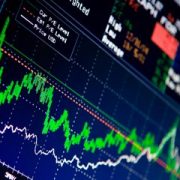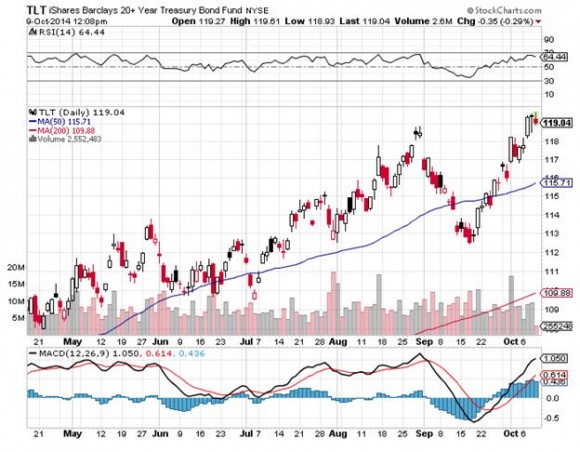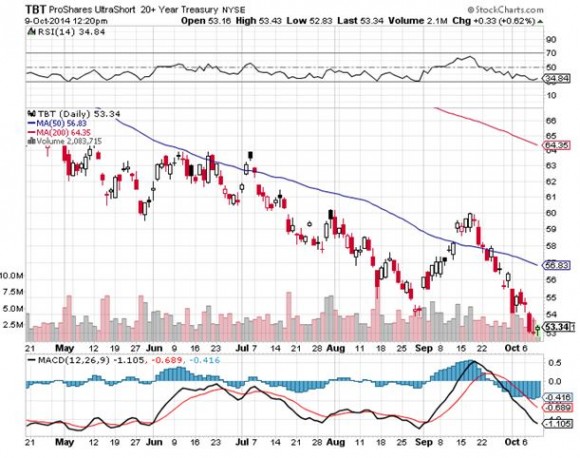As a potentially profitable opportunity presents itself, John will send you an alert with specific trade information as to what should be bought, when to buy it, and at what price. This is your chance to ?look over? John Thomas? shoulder as he gives you unparalleled insight on major world financial trends BEFORE they happen.
Further Update to: Trade Alert - (TLT)
Buy the iShares Barclay 20+ Year Treasury Bond Fund (TLT) November, 2014 $122-$125 in-the-money vertical bear put spread at $2.47 or best
Opening Trade
10-9-2013
expiration date: November 21, 2014
Portfolio weighting: 10%
Number of Contracts = 40
You can buy this put spread anywhere from $1.65 - $1.75 and have an excellent chance of making a good profit by the November expiration.
In terms of the ten year Treasury bond yield, the breakeven point for this spread is an incredibly low 2.15%. And it has only six weeks to get there. Bond mavens I respect highly don?t believe there is any chance we will get below 2.25% this year.
If you can?t do the options, this is a great entry point for the ProShares Ultra Short Treasury 20+ ETF (TBT) at $53.34.
I have never been one to run with the pack.
I?m the guy who eternally marches to a different drummer, not in the next town, but the other hemisphere.
I would never want to join a club that would lower its standards so far that it would invite me as a member.
On those rare times that I do join the lemmings, I am punished severely.
This is one of the times.
Like everyone and his brother, his fraternity mate, and his long lost cousin, I thought bonds would fall this year and interest rates would rise.
After all, this is normally what you get in the fifth year of an economic recovery. This is usually when corporate America starts to expand capacity and borrow money with both hands, driving rates up.
Although I was wrong on the market direction, Treasury bonds have been one of my top performing asset classes this year. I used every spike in prices to buy (TLT) vertical put spreads $3-$5 in the money, and raked in profits almost every month.
Then in July, with bonds at year highs, I switched to buying the ProShares Ultra Short Treasury 20+ ETF (TBT). I held that for two months, then I got out forever and quit the market. I went back into the (TBT) in September, and have been losing money ever since, down 75 basis points, or 0.75%.
Of course, looking back with laser sharp 20/20 hindsight, it is so clear why fixed income securities of every description have been on a tear all year. I will give you ten reasons why I have been wrong on bonds:
1) The Federal Reserve is pushing on a string, attempting to force companies to increase hiring, keeping interest rates at artificially low levels. My theory on why this isn?t working is that companies have become so efficient, thanks to hyper accelerating technology, that they don?t need humans anymore.
2) The US Treasury wants low rates to finance America?s massive $17.5 trillion national debt. Move rates from 0% to 6% and you have an instant financial crisis.
3) With Japan and Europe in a currency price war and a race to the bottom, the world is sending its money to the US to chase higher interest rates in an appreciating greenback, now at a four year peak, funneling more money into bonds. The choices for ten-year government bonds are Japan at 0.48%, Germany at 0.90%, and the US at 2.30%. It all makes our bonds look like a screaming bargain.
4) Since the 2009 peak, the US budget deficit has fallen the fastest in history, down 75% from $1.6 trillion to a mere $400 billion, and lower numbers beckon. Obama?s tax hikes did a lot to shore up the nation?s balance sheet. A growing economy also throws off a ton more in tax revenues. As a result, the Treasury is issuing far fewer bonds, creating a shortage.
5) This recovery has been led by small ticket auto purchases, not big ticket home purchases. The last real estate crash is still too recent a memory for many traumatized buyers, at least for those few who can get a mortgage. This keeps loan demand weak, and interest rates at subterranean levels.
6) The Fed?s policy of using asset price inflation to spur the economy has been wildly successful. But bonds are included in these assets, and they have benefited the most.
7) New rules imposed by Dodd-Frank force institutional investors to hold larger amounts of bonds than in the past.
8) The concentration of wealth with the top 1% also generates more bond purchases. It seems that once you become a billionaire, you become ultra conservative and only invest in safe fixed income products. This is happening globally. For more on this, click here for ?The 1% and the Bond Market?.
9) Inflation? Come again? What?s that? Commodity, energy, precious metal, and food prices are disappearing up their own exhaust pipes. Industrial revolutions produce deflationary centuries, and we have just entered the third one in history (after no. 1, steam, and no. 2, electricity).
10) The psychological effects of the 2008-2009 crash were so frightening that many investors will never recover. That means more bond buying and less buying of all other assets. I can?t tell you how many investment advisors I know who have converted their practices to bond only ones.
Having said all of that, I am selling bonds short once again, this time through the iShares Barclay 20+ Year Treasury Bond Fund (TLT) November, 2014 $122-$125 in-the-money vertical bear put spread.
Call me an ornery, stubborn, stupid old man.
But hey, even a blind squirrel finds an acorn once a day.
Even if I am still wrong, this position allows ten year Treasury bond rates to plunge all the way down to 2.15% and I?ll still breakeven.
The best execution can be had by placing your bid for the entire spread in the middle market and waiting for the market to come to you. The difference between the bid and the offer on these deep in-the-money spread trades can be enormous.
Don?t execute the legs individually or you will end up losing much of your profit.
Keep in mind that these are ballpark prices only. Spread pricing can be very volatile on expiration months farther out.
Here are the specific trades you need to execute this position:
Buy 40 November, 2014 (TLT) $125 puts at?????$6.70
Sell short 40 November, 2014 (TLT) $122 puts at..??.$4.23
Net Cost:??????????????????.....$2.47
Potential Profit: $3.00 - $2.47 = $0.53
(40 X 100 X $0.53) = $2,120 or 2.12% profit for the notional $100,000 portfolio.




